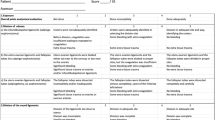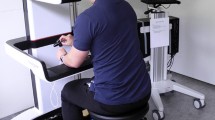Abstract
Background
Substantial evidence in the scientific literature supports the use of simulation for surgical education. However, curricula lack for complex laparoscopic procedures in gynecology. The objective was to evaluate the validity of a program that reproduces key specific components of a laparoscopic hysterectomy (LH) procedure until colpotomy on a virtual reality (VR) simulator and to develop an evidence-based and stepwise training curriculum.
Methods
This prospective cohort study was conducted in a Marseille teaching hospital. Forty participants were enrolled and were divided into experienced (senior surgeons who had performed more than 100 LH; n = 8), intermediate (surgical trainees who had performed 2–10 LH; n = 8) and inexperienced (n = 24) groups. Baselines were assessed on a validated basic task. Participants were tested for the LH procedure on a high-fidelity VR simulator. Validity evidence was proposed as the ability to differentiate between the three levels of experience. Inexperienced subjects performed ten repetitions for learning curve analysis. Proficiency measures were based on experienced surgeons’ performances. Outcome measures were simulator-derived metrics and Objective Structured Assessment of Technical Skills (OSATS) scores.
Results
Quantitative analysis found significant inter-group differences between experienced intermediate and inexperienced groups for time (1369, 2385 and 3370 s; p < 0.001), number of movements (2033, 3195 and 4056; p = 0.001), path length (3390, 4526 and 5749 cm; p = 0.002), idle time (357, 654 and 747 s; p = 0.001), respect for tissue (24, 40 and 84; p = 0.01) and number of bladder injuries (0.13, 0 and 4.27; p < 0.001). Learning curves plateaued at the 2nd to 6th repetition. Further qualitative analysis found significant inter-group OSATS score differences at first repetition (22, 15 and 8, respectively; p < 0.001) and second repetition (25.5, 19.5 and 14; p < 0.001).
Conclusions
The VR program for LH accrued validity evidence and allowed the development of a training curriculum using a structured scientific methodology.





Similar content being viewed by others
References
Kohn LT, Corrigan JM, Donaldson MS (2000) To err is human: building a safer health system. Institute of Medicine (US) Committee on Quality of Health Care in America. National Academies Press (US). http://www.ncbi.nlm.nih.gov/books/NBK225182/
Zendejas B, Brydges R, Hamstra SJ, Cook DA (2013) State of the evidence on simulation-based training for laparoscopic surgery: a systematic review. Ann Surg 257(4):586–593
Dedy NJ, Bonrath EM, Zevin B, Grantcharov TP (2013) Teaching nontechnical skills in surgical residency: a systematic review of current approaches and outcomes. Surgery 154(5):1000–1008
Fraser SA, Klassen DR, Feldman LS, Ghitulescu GA, Stanbridge D, Fried GM (2003) Evaluating laparoscopic skills: setting the pass/fail score for the MISTELS system. Surg Endosc 17(6):964–967
Aggarwal R, Tully A, Grantcharov T, Larsen CR, Miskry T, Farthing A, Darzi A (2006) Virtual reality simulation training can improve technical skills during laparoscopic salpingectomy for ectopic pregnancy. BJOG 113(12):1382–1387
Aggarwal R, Crochet P, Dias A, Misra A, Ziprin P, Darzi A (2009) Development of a virtual reality training curriculum for laparoscopic cholecystectomy. Br J Surg 96(9):1086–1093
Stefanidis D, Sevdalis N, Paige J, Zevin B, Aggarwal R, Grantcharov T, Jones DB (2015) Simulation in surgery: what’s needed next? Ann Surg 261(5):846–853
Igwe E, Hernandez E, Rose S, Uppal S (2014) Resident participation in laparoscopic hysterectomy: impact of trainee involvement on operative times and surgical outcomes. Am J Obstet Gynecol 211(5):484.e1–484.e7
Reich H (2007) Total laparoscopic hysterectomy: indications, techniques and outcomes. Curr Opin Obstet Gynecol 19(4):337–344
Donnez O, Jadoul P, Squifflet J, Donnez J (2009) A series of 3190 laparoscopic hysterectomies for benign disease from 1990 to 2006: evaluation of complications compared with vaginal and abdominal procedures. BJOG 116(4):492–500
Fundamentals of Laparoscopic Surgery—the definitive laparoscopic skills enhancement and assessment module. http://www.flsprogram.org/
Joint Committee on Standards for Educational and Psychological Testing APA, American Educational Research Association and National Council on Measurement in Education (1999) Standards for educational and psychological testing. Washington, DC
Ahmed K, Miskovic D, Darzi A, Athanasiou T, Hanna GB (2011) Observational tools for assessment of procedural skills: a systematic review. Am J Surg 202(4):469–480
Martin JA, Regehr G, Reznick R, MacRae H, Murnaghan J, Hutchison C, Brown M (1997) Objective structured assessment of technical skill (OSATS) for surgical residents. Br J Surg 84(2):273–278
Aggarwal R, Grantcharov T, Moorthy K, Milland T, Darzi A (2008) Toward feasible, valid, and reliable video-based assessments of technical surgical skills in the operating room. Ann Surg 247(2):372–379
Aggarwal R, Grantcharov T, Moorthy K, Hance J, Darzi A (2006) A competency-based virtual reality training curriculum for the acquisition of laparoscopic psychomotor skill. Am J Surg 191(1):128–133
Aggarwal R, Grantcharov TP, Eriksen JR, Blirup D, Kristiansen VB, Funch-Jensen P, Darzi A (2006) An evidence-based virtual reality training program for novice laparoscopic surgeons. Ann Surg 244(2):310–314
Tunitsky-Bitton E, Propst K, Muffly T (2016) Development and validation of a laparoscopic hysterectomy cuff closure simulation model for surgical training. Am J Obstet Gynecol 214(3):392.e1–392.e6
King CR, Donnellan N, Guido R, Ecker A, Althouse AD, Mansuria S (2015) Development and validation of a laparoscopic simulation model for suturing the vaginal cuff. Obstet Gynecol 126(Suppl 4):27S–35S
Crochet P, Aggarwal R, Berdah S, Yaribakht S, Boubli L, Gamerre M, Agostini A (2014) Current and future use of surgical skills simulation in gynecologic resident education: a French national survey. J Gynecol Obstet Biol Reprod (Paris) 43(5):379–386 (in French)
Wattiez A, Soriano D, Cohen SB, Nervo P, Canis M, Botchorishvili R, Mage G, Pouly JL, Mille P, Bruhat MA (2002) The learning curve of total laparoscopic hysterectomy: comparative analysis of 1647 cases. J Am Assoc Gynecol Laparosc 9(3):339–345
Larsen CR, Soerensen JL, Grantcharov TP, Dalsgaard T, Schouenborg L, Ottosen C, Schroeder TV, Ottesen BS (2009) Effect of virtual reality training on laparoscopic surgery: randomised controlled trial. BMJ 338:b1802
Crochet P, Aggarwal R, Dubb SS, Ziprin P, Rajaretnam N, Grantcharov T, Ericsson KA, Darzi A (2011) Deliberate practice on a virtual reality laparoscopic simulator enhances the quality of surgical technical skills. Ann Surg 253(6):1216–1222
Palter VN, Grantcharov TP (2014) Individualized deliberate practice on a virtual reality simulator improves technical performance of surgical novices in the operating room: a randomized controlled trial. Ann Surg 259(3):443–448
Arora S, Aggarwal R, Moran A, Sirimanna P, Crochet P, Darzi A, Kneebone R, Sevdalis N (2011) Mental practice: effective stress management training for novice surgeons. J Am Coll Surg 212(2):225–233
Acknowledgments
The authors thank Marine Alessandrini for her contribution to this project (Service de santé publique et d’information médicale, centre hospitalier universitaire Timone, 13385 Marseille, Aix Marseille université, France).
Funding
CERC (Centre d’Enseignement et de Recherche Chirurgicale), Aix Marseille Université, Assistance Publique - Hôpitaux de Marseille. Rajesh Aggarwal was funded by “Fonds de recherche santé Québec” and “Montréal General Hospital Foundation.”
Author information
Authors and Affiliations
Corresponding author
Ethics declarations
Disclosure
Rajesh Aggarwal is a consultant for Applied Medical. Patrice Crochet, Sophie Knight, Stéphane Berdah, Léon Boubli and Aubert Agostini have no conflicts of interest or financial ties to disclose.
Rights and permissions
About this article
Cite this article
Crochet, P., Aggarwal, R., Knight, S. et al. Development of an evidence-based training program for laparoscopic hysterectomy on a virtual reality simulator. Surg Endosc 31, 2474–2482 (2017). https://doi.org/10.1007/s00464-016-5249-3
Received:
Accepted:
Published:
Issue Date:
DOI: https://doi.org/10.1007/s00464-016-5249-3




